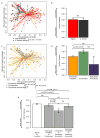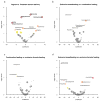Association of Cesarean Delivery and Formula Supplementation With the Intestinal Microbiome of 6-Week-Old Infants
- PMID: 26752321
- PMCID: PMC4783194
- DOI: 10.1001/jamapediatrics.2015.3732
Association of Cesarean Delivery and Formula Supplementation With the Intestinal Microbiome of 6-Week-Old Infants
Abstract
Importance: The intestinal microbiome plays a critical role in infant development, and delivery mode and feeding method (breast milk vs formula) are determinants of its composition. However, the importance of delivery mode beyond the first days of life is unknown, and studies of associations between infant feeding and microbiome composition have been generally limited to comparisons between exclusively breastfed and formula-fed infants, with little consideration given to combination feeding of both breast milk and formula.
Objective: To examine the associations of delivery mode and feeding method with infant intestinal microbiome composition at approximately 6 weeks of life.
Design, setting, and participants: Prospective observational study of 102 infants followed up as part of a US pregnancy cohort study.
Exposures: Delivery mode was abstracted from delivery medical records, and feeding method prior to the time of stool collection was ascertained through detailed questionnaires.
Main outcomes and measures: Stool microbiome composition was characterized using next-generation sequencing of the 16S rRNA gene.
Results: There were 102 infants (mean gestational age, 39.7 weeks; range, 37.1-41.9 weeks) included in this study, of whom 70 were delivered vaginally and 32 by cesarean delivery. In the first 6 weeks of life, 70 were exclusively breastfed, 26 received combination feeding, and 6 were exclusively formula fed. We identified independent associations between microbial community composition and both delivery mode (P< .001; Q < .001) and feeding method (P = .01; Q < .001). Differences in microbial community composition between vaginally delivered infants and infants delivered by cesarean birth were equivalent to or significantly larger than those between feeding groups (P = .003). Bacterial communities associated with combination feeding were more similar to those associated with exclusive formula feeding than exclusive breastfeeding (P = .002). We identified 6 individual bacterial genera that were differentially abundant between delivery mode and feeding groups.
Conclusions and relevance: The infant intestinal microbiome at approximately 6 weeks of age is significantly associated with both delivery mode and feeding method, and the supplementation of breast milk feeding with formula is associated with a microbiome composition that resembles that of infants who are exclusively formula fed. These results may inform feeding choices and shed light on the mechanisms behind the lifelong health consequences of delivery and infant feeding modalities.
Conflict of interest statement
Figures


Comment in
-
Intestinal Microbiota and Health of Adults Who Were Born by Cesarean Delivery.JAMA Pediatr. 2016 Oct 1;170(10):1027. doi: 10.1001/jamapediatrics.2016.2310. JAMA Pediatr. 2016. PMID: 27548071 No abstract available.
References
Publication types
MeSH terms
Grants and funding
- NLM R01 LM010098/PHS HHS/United States
- NIEHS P20ES018175/ES/NIEHS NIH HHS/United States
- K01 LM011985/LM/NLM NIH HHS/United States
- P30 ES013508/ES/NIEHS NIH HHS/United States
- P20 ES018175/ES/NIEHS NIH HHS/United States
- R01 LM010098/LM/NLM NIH HHS/United States
- P01 ES022832/ES/NIEHS NIH HHS/United States
- NLM K01LM011985/PHS HHS/United States
- R01 LM009012/LM/NLM NIH HHS/United States
- NIGMS P20GM104416/PHS HHS/United States
- R25 CA134286/CA/NCI NIH HHS/United States
- P20 GM104416/GM/NIGMS NIH HHS/United States
- NIEHS P01ES022832/ES/NIEHS NIH HHS/United States
- R01LM009012/LM/NLM NIH HHS/United States
LinkOut - more resources
Full Text Sources
Other Literature Sources
Medical
Molecular Biology Databases

